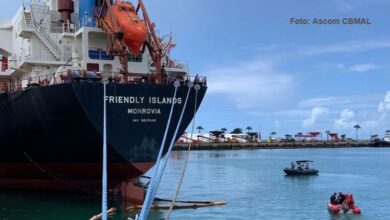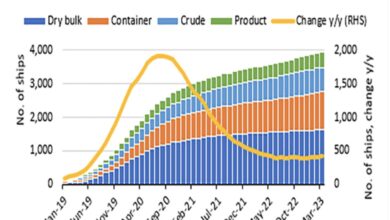Reaping digital rewards: API pot of gold at the end of the rainbow for shipping

Data-sharing could unlock billions of dollars in commercial benefits for shipping as well as accelerate decarbonization. But legacy systems and a restrictive mindset are hindering the industry’s digital transformation and stalling the vital transition to an API economy seen in other industries.
Economic modeling carried out by UK-based consultancy Critical Future has shown that industry players could realize up to $237 billion in additional value within 2027 by adopting a business model based on sharing data, which could boost profitability by 14%-19% depending on vessel type.
The firm stated in a White Paper that “sharing non-confidential data such as fleet management information could unleash substantial productivity gains”.
“The benefits would include improved vessel operations efficiency, with increased net revenue for shipping firms, and broader societal gains in terms of sustainability,” according to the recent study, commissioned by US-based software-as-a-service (SaaS) provider OrbitMI.
The drive for decarbonization will require the industry to provide reliable, independently validated data on emissions that will have to be aggregated into a data pool for analysis to enable operational efficiencies across fleets.
Sustainability goal
This means that ship operators will need to collaborate through data-sharing to achieve the common goal of sustainability, which will require a major shift from the competitive mindset that currently prevails in the industry.
The enormous benefits of data-sharing have already been seen in land-based industries, most notably in the medical sector as biotech companies have collaborated to develop life-saving vaccines in record time to combat the Covid-19 pandemic.
The maritime industry generates huge volumes of data from different aspects of ship operation including navigation, fuel consumption, and engine condition, as well as in chartering, port logistics, bunkering, insurance, class, legal, finance, regulatory and other areas.
But the study stated: “Maritime data is currently not shared by key stakeholders, and therefore shipping operators can fail to gain the full picture. This has implications for risk management, vessel efficiency, and sustainability as fuel consumption increases.”
Silo thinking
While the industry already uses software to support operations, much of the data generated from multiple systems, diverse sources, standard reports, and emails between departments remains effectively stored in silos and underutilized – and this slows down decision-making.
But data is like oil: it remains of limited use unless it is refined. To gain value from this data, Big Data methods such as AI-driven machine learning and blockchain technology are required to synthesize, analyze and understand it to deliver actionable insights to make the right decisions in support of sustainability and profitability.
Big Data analysis offers hindsight to understand what has happened in the past, insight to focus on what is happening now, and foresight so that data can be used to predict what happens next.
This is valuable, for example, in gaining actionable insights into fuel consumption and engine efficiency to achieve cost and emission reductions from analysis of data collected in line with the Marpol-mandated Shipboard Energy Efficiency Management Plan.
Leveraging data
Similarly, there is now an increasing trend towards an internet of things onboard with the use of digital sensors connecting equipment such as engines and propulsion systems, generating real-time data for cost-effective condition monitoring and preventive maintenance.
A recent study by weather intelligence firm DTN around digitalization in shipping also shows that integrating weather-enhanced data not only secures crew, vessel, and cargo safety, it improves fuel efficiency and decarbonization efforts.
Some shipping companies are waking up to the opportunity of leveraging shared data to optimize vessel performance, such as Wallenius Wilhelmsen has integrated weather and port information streamed from external sources into the flow of operational data from its fleet.
Its chief digital officer Simon White stresses that value comes from how data is combined, contextualized, and embedded in processes.
“An obvious case is how we combine vessel, weather and port data with cargo forecasts to optimise ocean voyages. This allows better planning and improved predictability – and critically, it also dramatically reduces energy consumption and emissions,” he says.
And he adds: “For me, digitalisation and sustainability are two sides of the same coin.”
Integrated systems
The explosion of advanced data, along with increasing access to real-time insights, means that systems need to be able to process and package the data in a way that is easy to access and understand. DTN, therefore, provides its weather-enhanced data to SaaS companies that provide integrated data solutions.
“Fully leveraging weather intelligence within integrated systems provides foresight and planning across the full distribution chain, enabling confident decisions, and accelerating digitalization in the industry as a whole,” notes Jarco van der Brink, Strategic Product Manager at DTN.
However, while many shipowners have invested in cloud-based digital solutions, most have stuck with legacy analogue systems and processes to manage their fleets and continue to operate as they have for decades.
Aging and inflexible IT infrastructure, along with the cost and complexity of replacing legacy systems and a lack of standardized infrastructure, are seen as key impediments to improving visibility and collaboration in the shipping industry.
Industry inertia
There is also a high degree of industry inertia in migrating to cloud-based digital systems, driven by cybersecurity and digital trust concerns, as well as doubts over the potential commercial benefits, a lack of training, and little understanding of the relative merits of different software.
One of the biggest obstacles to digital transformation in shipping is the traditional competitive and highly secretive mindset of the industry that makes it averse to transparency and data-sharing, according to the Critical Future study.
Although the necessary technologies already exist, the industry must find ways to overcome this narrow mindset through greater collaboration among shipowners, vendors, and other stakeholders to meet the challenges and opportunities of digitalization, which transcend any single company.
Unfortunately, vendors are equally paranoid about data-sharing given their business models rely on the quality of their data, which makes them reluctant to share it. Because data is formatted in different ways by different vendors, there are no viable standards or infrastructure to link data generated by different proprietary platforms.

API economy
This lack of transparency and stubborn reliance on legacy systems has resulted in a highly fragmented digital landscape that generates a lot of dormant data locked in silos, which may allow for innovation within the vendor’s own platform but not across different platforms and systems.
Joining the API economy would enable shipping to fully leverage the potential of cloud-based digital systems. An Application Programming Interface (API) creates standards that allow multiple vendors to share select data across platforms without compromising sensitive, business-critical information.
APIs make it possible, for example, to use Google Maps and weather data in different applications or travel booking websites to aggregate hundreds of different routes from multiple airlines, as well as facilitate the seamless and secure transfer of money from one bank to another.
These can be compared to the standardized twist-lock connector system found on containers that enables them to be secured to each other, a truck, rail car, or ship. In the same way, APIs act as standardized connectors between applications, but do not require full transparency, thus easing confidentiality concerns expressed by owners and vendors alike.
Vendor selection challenge
Participation in the API economy will therefore necessitate standardization across platforms as well as the development of a common ‘language’ that is understood by different software vendors and other stakeholders.
Lloyd’s Register’s head of marketing for maritime performance services, Mark Warner, has highlighted several ‘digital pivots’ for industry transformation, including a flexible, secure and connected infrastructure both onboard and onshore, transfer and analysis of data from ship to shore to avoid silos, and intelligent and automated workflows – with a shift to a “digital-first mindset”.
The growth of the API trend has given rise to progressive software providers such as OrbitMI, which offers vessel performance management, DTN, and communication software specialist Sedna whose applications are designed for integration and compatibility independent of hardware.
But OrbitMI’s chief marketing officer David Levy says: “Not all software vendors are created equal so proper benchmarking analysis is needed by the industry to enable shipowners to select applications that can meet their requirements and deliver an effective return on investment.”

















